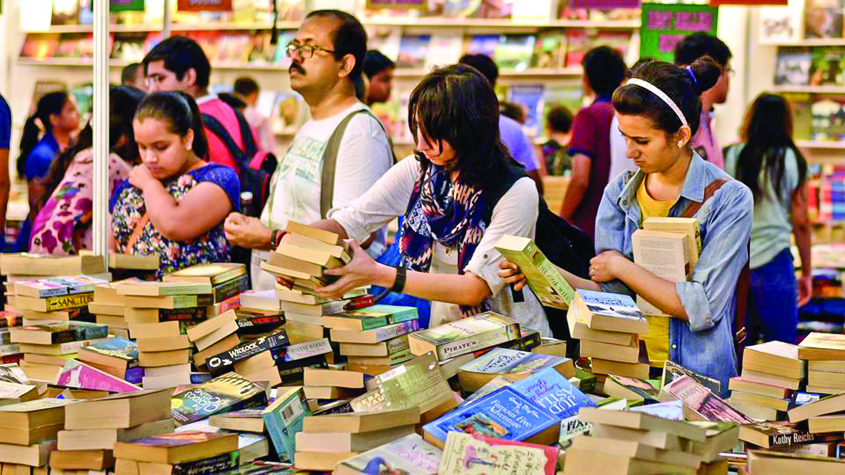Baldeo Bhai Sharma, Chairman, NBT, said that this edition of the fair was very special for NBT as it was the silver jubilee of the book fair and also because NBT was celebrating 60 years since its founding this year. “India is the land of learning and women have played a significant role in carrying forward the tradition of learning since Vedic times. ‘Manushi’, which is the event’s theme this year, is going to help depict our major contributions in spreading knowledge.”
NBT has brought out a “Manushi” catalogue which makes an attempt to showcase the exemplary work done by women and bringing into view different issues related to women — ranging from fiction and poetry to popular science and children’s literature — and in all languages. It includes an eclectic mix of Assamese translations of Ashapurna Devi and Mahasweta Devi’s works; Kiran Sehgal’s loving tribute to her mother — the very talented actor Zohra Sehgal, entitled in English Zohra Sehgal Fatty; Nabanita Kanungo’s debut collection of poems A Map of Ruins (again, in English); Renu Gavaskar’s Marathi book titled Amacha Kay Gunha? (What is our Crime?), which deals with problems faced by institutionalised children/juvenile delinquents; Odisha Sahitya Academy awardee Shakuntala Devi’s compilation of poems titled Abichhinna Mana; the very popular Telegu writer Sudha Murthy’s short stories-cum-autobiographical anecdotes titled Ammamma Chaduvu, among many others.
“This catalogue serves the purpose of being a representative collection of selected books as every book touching upon the subject cannot possibly be covered in one volume. However, a sincere attempt has been made to incorporate the books made available to us. Some works which could not be included in the catalogue will be on display at the Theme Pavilion,” Dr Rita Chowdhury, Director of NBT, tells Guardian 20.
The Pavilion, apparently, has been set up to host a range of talks, discussions as well as cultural programmes throughout the duration of the fair. On the opening day of the fair, Sattriya, a classical dance from Assam, was presented at one of the pavilions by a group of school girls. The opening panel discussion was by noted Odia writer and Jnanpith awardee, Dr Pratibha Ray, who was in a discussion titled “My Life, My Literature”. According to Ray, literature is beyond gender and geography and that all writers are humanists, male or female. “There are two qualities in a writer: love and fearlessness. Without love and fearlessness, one cannot become a writer. At the age of nine, I fell in love with nature — river, trees, etc. I imagined the bindi on my mother’s forehead as the rising sun. After seeing my childhood friends suffer from caste discrimination, I had questioned my father about the existence of discrimination. What I believe, I practise. I am seeking for an unconditional love which is yet to be found. I am a lone traveler and having visited around 40 countries and during difficult times too can say that among all the people of different nationalities that I have met, Pakistanis specially, have come to my greatest assistance. I like to stay anonymous while travelling and that is how I am able to understand the fact that every human being is basically good. Only the visa I possess, while travelling, confirms to which country I belong,” said Ray.
The fair had a designated Authors’ Corner which saw a healthy open interaction with readers who came along. A promising, young journalist Pallavi Rebbapagada launched and discussed her debut book Upon a Bright Red Bench — a collection of short stories.
Further on, Ray added that NBT should initiate a campaign for Right to Literature (RTL), with the message that everyone has the right to read and create a character of their own.
The fair had a designated Authors’ Corner, which saw a healthy open interaction with readers who came along. A promising, young journalist Pallavi Rebbapragada launched and discussed her debut book Upon a Bright Red Bench — a collection of short stories. On being asked whether there was a personal connect with the metaphor “red bench”, which is a central part of her book, Rebbapragada said, “As a journalist, I have only told the stories of other people. As an author, I wanted to use the neutral and objective eyes of a bench to peep into the lives of others. The bench is observant, detached and philosophical. I’d want my readers to think it’s a bench that’s talking to them. When we go and sit on a bench, in silence, we come closer to our imagination. I want my readers to befriend their own mad and wild imaginations through mine. The bench is only a catalyst.”
She added: “The world is full of big and small stories, each as intriguing as the other. I wanted to tell many stories—of loss, nostalgia, greed, confusion, stupidity, acceptance, friendship—and it felt right that I let each story have its own vibe. So, I tied them up through a concept: half-human, half-thing.”
The idea of the Indian woman is indeed not a homogenous one and depicting her in Indian languages corroborates her plurality or differences in cultural realities. In a session titled “Authoring in Various Languages”, V.M. Girija (Malayalam), together with Dr Swati Guha (Bangla) and Dr Anamika (Hindi) came together to discuss this very idea of the Indian woman. While reading out an English version of her poem titled Sleeping Poem, Girija discussed the ambiguity in representing herself. She questioned, “Who is an Indian woman? Are they women of slums, women of city, Adivasi women? Is there an India that portrays a proper India? I, therefore, write about her in the language in which I can touch, see, feel her.”

